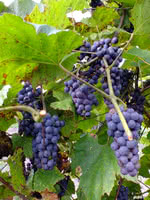Mon-Fri 9am - 5pm Mountain time
Amur Grape vs Bilberry
Vaccinium myrtillus
Vitis amurensis
CUSTOM GROW
NOT AVAILABLE THIS SEASON - MIGHT RETURN
Bilberry is a native perennial shrub valued for its small, blue-black berries that ripen in mid to late summer. The berries resemble blueberries but have a richer, more tart, and intense flavor. They have long been used for fresh eating, baking, and preserves, while also providing food for birds and mammals. In spring, its delicate pinkish flowers attract bees and other pollinators.
Growing low to the ground, Bilberry forms spreading colonies that create dense understory cover. This growth habit provides food and shelter for wildlife, and its foliage adds seasonal interest by turning red to purple in autumn. With its adaptability and ecological benefits, Bilberry is well-suited for naturalization, ecological restoration, and pollinator gardens.
The Amur Grape is an ornamental grape that fruits dark, sour, juicy grapes later in the fall. It is native to Asia, and found growing wild in Russia and China. It’s one of the most cold-hardy grape varieties, prized for its foliage that turns from a bright green to a deep crimson and purple in the fall. The flowers are small and white, usually appearing in the beginning of May.
The name for the Amur Grape comes from the Amur Valley, located in Russia. It’s extremely resistant to frost. The berries are good for fresh eating, but also make a flavorful addition to any homemade wines and preserves. The leaves are also edible, and are commonly used in salads. This plant does best with a trellis.
Note: We do not ship grape vines to BC due to regulatory restrictions from the Canadian Food Inspection Agency.
Bilberry Quick Facts
Amur Grape Quick Facts
Toxicity: leaves may be unsafe in high doses

